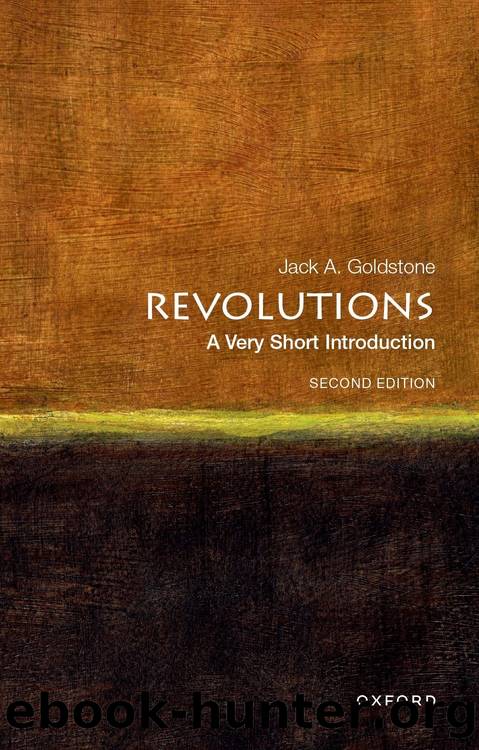Revolutions by Jack A. Goldstone

Author:Jack A. Goldstone [Goldstone, Jack A.]
Language: eng
Format: epub
ISBN: 9780197666326
Publisher: Oxford University Press
Published: 2023-08-28T00:00:00+00:00
3. After the American Revolution, disputes among the former colonies and concerns about credit and commerce led to demands for a stronger central government for the new nation. In 1787 the former colonies sent representatives to negotiate and draw up a new constitution for the United States. Howard Chandler Christyâs painting of the signing of the Constitution hangs in the U.S. Capitol.
The French Revolution
The American Revolution seemed radical to Europeans, but it was also quite distant. Yet revolution would soon strike the largest country in Europe. Despite Franceâs success in the American War of Independence, its accumulated war debts and the imminent expiration of wartime tax measures created a fiscal crisis. When French law courts and notables rejected proposed new taxes, the king was pressured to call a meeting of the representatives of the three estates of the realmâthe clergy, nobility, and commonersâto seek a solution.
The Estates met in May 1789, after a year of famine had spurred riots across the country, and expectations ran high for major political and economic reforms. Yet the Estates immediately broke down into acrimony. The clergy and nobility insisted on voting by Estates, so that their votes would always outweigh those of the commoners, known as the Third Estate. However, the Third Estate was filled with professionals and bureaucrats who had sought or were even in the process of acquiring noble status themselves, as the eighteenth century had been a period of considerable social mobility; they were enraged at being treated as insignificant. Their rage was shared by abbots and priests who were also treated as commoners by the privileged bishops. The Abbé Sieyès wrote: âWhat is the Third Estate? Everything. What has it been until now in the public order? Nothing.â
After weeks of deadlock, the representatives of the Third Estate proclaimed that they spoke for the entire nation. Reconstituting themselves as the National Assembly and joined by reformers from the other Estates, they set out to reshape France. They produced a Declaration of the Rights of Man and of the Citizen, and from 1789 to 1793 the Assembly, and the elected Legislative Assembly and National Convention that followed, abolished the monarchy and all feudal privileges, nationalized the church, and executed King Louis XVI and his elegant queen, Marie Antoinette. France was declared a republic, under the motto Liberté, Ãgalité, Fraternité. The French revolutionaries saw themselves as repeating the feats of the early Romans who had overthrown their king and founded a republic, depicting themselves in togas and calling their military leaders âconsulsâ after the old Roman term.
The actions of the national assemblies and conventions were spurred by popular uprisings in Paris and the provinces. In 1789, fearing that the king would disperse the new National Assembly, Parisian workers armed themselves and attacked a royal fortress, the Bastille. Supported by a detachment of renegade soldiers with artillery, the crowds took the Bastille on July 14.
Foreign powers grew alarmed and attacked the new republic. Within France, several provinces resisted the nationalization of the church and the new demands of the revolutionary government, producing a civil war as well.
Download
This site does not store any files on its server. We only index and link to content provided by other sites. Please contact the content providers to delete copyright contents if any and email us, we'll remove relevant links or contents immediately.
Cecilia; Or, Memoirs of an Heiress — Volume 1 by Fanny Burney(31351)
Cecilia; Or, Memoirs of an Heiress — Volume 3 by Fanny Burney(30949)
Cecilia; Or, Memoirs of an Heiress — Volume 2 by Fanny Burney(30907)
The Great Music City by Andrea Baker(21572)
We're Going to Need More Wine by Gabrielle Union(18086)
Bombshells: Glamour Girls of a Lifetime by Sullivan Steve(13119)
Pimp by Iceberg Slim(12946)
All the Missing Girls by Megan Miranda(12774)
Fifty Shades Freed by E L James(12463)
Talking to Strangers by Malcolm Gladwell(11907)
Norse Mythology by Gaiman Neil(11901)
Crazy Rich Asians by Kevin Kwan(8372)
Mindhunter: Inside the FBI's Elite Serial Crime Unit by John E. Douglas & Mark Olshaker(7850)
The Lost Art of Listening by Michael P. Nichols(6483)
Enlightenment Now: The Case for Reason, Science, Humanism, and Progress by Steven Pinker(6414)
Bad Blood by John Carreyrou(5782)
The Four Agreements by Don Miguel Ruiz(5532)
Weapons of Math Destruction by Cathy O'Neil(5046)
We Need to Talk by Celeste Headlee(4881)
